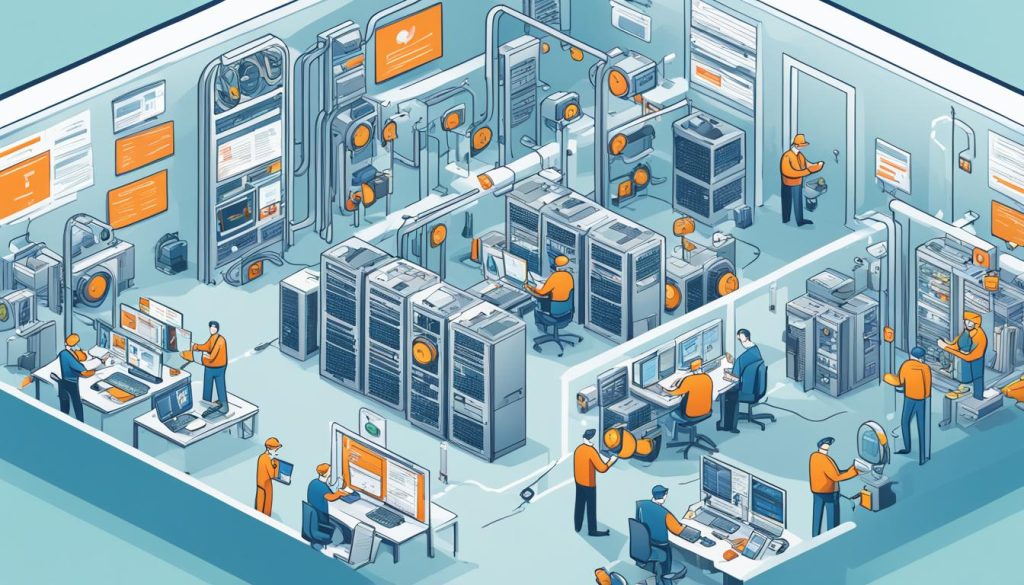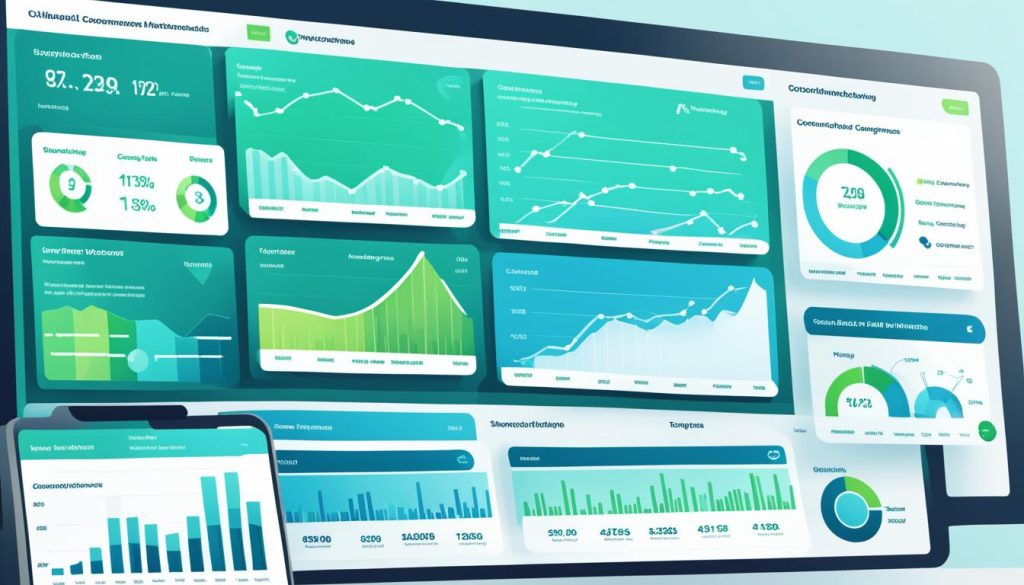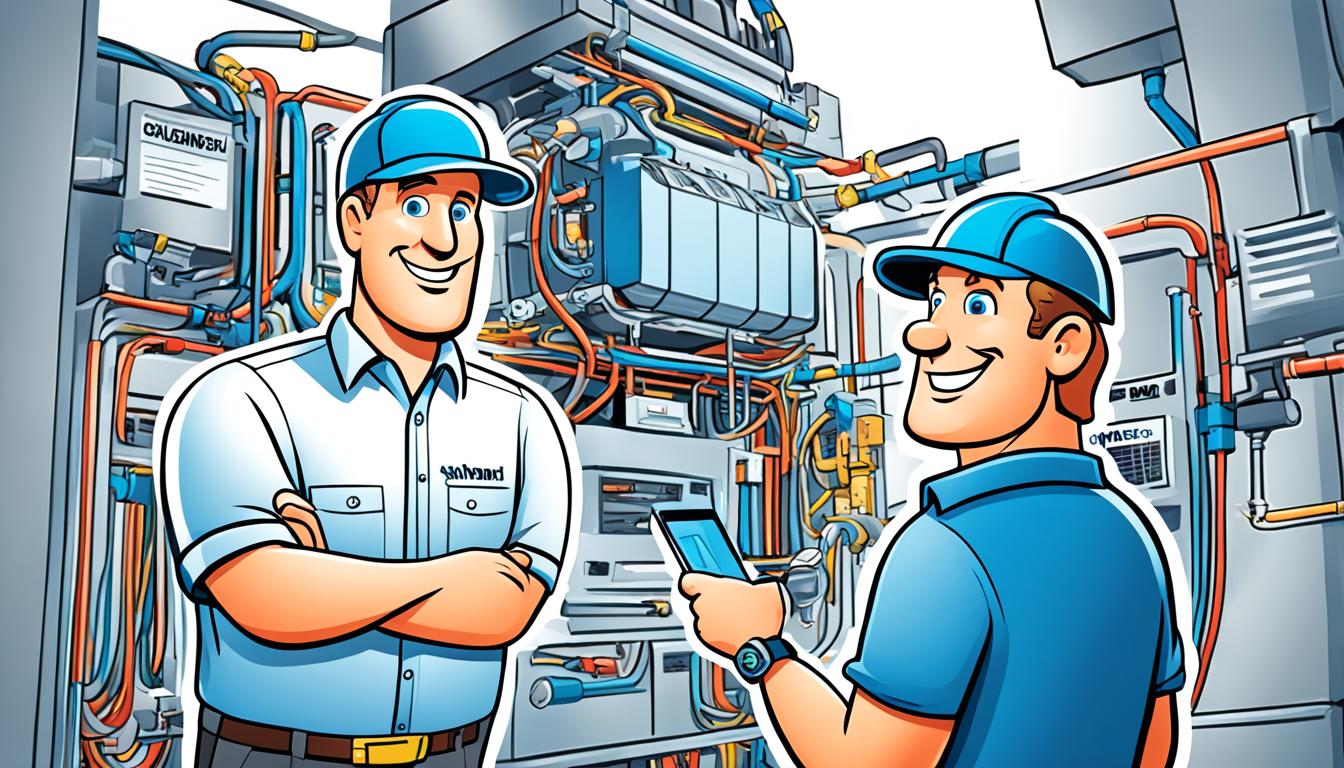You can make your software ecosystem smooth by linking your HVAC dispatch programs with other tools. This makes your work flow better and boosts efficiency. By joining your dispatch software with other systems, you create a strong platform for your HVAC business.
Integrating HVAC software lets you use the best parts of different programs together. Your dispatch system can work well with inventory, CRM, and mobile field service tools. This way, you avoid data gaps and cut down on mistakes from manual entries.
A seamless ecosystem means data moves smoothly between departments in real-time. Technicians can see the latest customer info and inventory levels on the go. At the same time, office staff can keep track of service progress and manage schedules better. This integration means better customer service and more work done.
By going for software integration, you’re setting your HVAC business up for growth and success in a digital world. The next parts will show you how to make this ecosystem, covering important points and best practices.
Understanding the HVAC Service Dispatch Software Landscape
HVAC dispatch software changes how heating, ventilation, and air conditioning businesses work. It makes handling service requests easier, schedules technicians automatically, and boosts efficiency.
Definition and Core Functionalities
HVAC dispatch software is a digital tool that helps manage service calls and tech assignments. It has key features like:
- Real-time job tracking
- Automated dispatching
- Team management
- Customer info storage
- Work order creation and management
Key Benefits for HVAC Businesses
Using HVAC dispatch software offers big advantages:
- It cuts down on travel time and fuel costs
- Improves customer service with quicker responses
- Better inventory management
- Boosts productivity and profits
- Less paperwork and fewer mistakes
Current Market Trends and Adoption Rates
The HVAC industry is quickly adopting dispatch software. Trends include:
- More small to medium-sized businesses are joining in
- Cloud-based solutions are in high demand
- Integration with tools like CRM and accounting
- Mobile access for field techs
With more competition, HVAC companies are using dispatch software to stay ahead. They aim to meet customer needs for quick and efficient service.
The Importance of Software Integration in HVAC Operations
Software integration is key to making HVAC operations run smoother. It connects different systems, making things more efficient and workflow better. Let’s see how software can change your HVAC business for the better.
When you link dispatch programs with other tools, you get a smooth system. This setup automates scheduling and cuts down on manual work. It also lowers the chance of mistakes in your daily tasks.
Real-time tracking of technicians becomes easier, making them quicker to respond and more accountable.
Linking your HVAC dispatch software with CRM and inventory systems boosts customer service. Technicians can check on parts and supplies easily, making sure they’re ready for each job.
| Integration Benefits | Impact on HVAC Operations |
|---|---|
| Automated Scheduling | Reduced manual labor, fewer errors |
| Real-time Tracking | Improved response times, increased accountability |
| CRM Integration | Enhanced customer service, personalized interactions |
| Inventory Management | Better parts availability, reduced downtime |
Using software integration in your HVAC work makes things more efficient, cuts costs, and uses resources better. This smart move helps your business grow and succeed in a tough market.
Create a Seamless Software Ecosystem by Integrating HVAC Dispatch Programs
Starting with HVAC dispatch programs is key to a smooth software ecosystem for your business. This makes things more efficient and simplifies how things work. Let’s see how to bring HVAC dispatch programs together and tackle common issues.
Identifying Integration Opportunities
Find spots where your dispatch software can link up with other systems. CRM, inventory tracking, and mobile apps are great choices. These connections can really help your business run better.
Steps to Achieve Seamless Integration
Here are steps to make a unified software ecosystem:
- Assess your current systems
- Choose compatible software
- Plan a phased integration approach
- Test thoroughly before full implementation
- Train staff on new integrated systems
Overcoming Integration Challenges
There are challenges when integrating systems. Moving data, getting staff to adapt, and making sure systems work together are common problems. Overcome these with careful planning and strong support.
| Challenge | Solution |
|---|---|
| Data Migration | Use specialized migration tools |
| Staff Resistance | Provide comprehensive training |
| System Compatibility | Choose software with open APIs |
By tackling these points, you can build a seamless software ecosystem that boosts your HVAC business. Remember, keeping it running smoothly needs ongoing support and regular updates.
Enhancing Operational Efficiency Through Integrated Systems
Integrated systems are changing the game for HVAC operations. They make things run smoother and more efficiently. By linking dispatch programs with other tools, businesses can make their processes better and work smarter.
Streamlining Workflow Processes
At the core of integrated systems is workflow optimization. When dispatch software talks to other tools without hitches, you cut out the wait and the repeat tasks. This means jobs get assigned faster, customers are happier, and everyone works better together.

Reducing Manual Data Entry and Errors
Integrated systems cut down on manual data entry big time. With automated data flow, mistakes are fewer and so is the time wasted. Your team can dive into what they do best, making them more productive and precise.
Improving Resource Allocation and Scheduling
With integrated systems, managing resources gets a whole lot easier. Smart scheduling looks at who’s available, what they can do, and where they need to go. This means the right person gets the right job, cutting down on travel and boosting success rates on the first try.
| Benefit | Impact on Operational Efficiency |
|---|---|
| Streamlined Workflows | Faster job completion and improved customer satisfaction |
| Reduced Manual Data Entry | Fewer errors and increased productivity |
| Optimized Resource Allocation | Better utilization of technician skills and time |
By going for integrated systems, HVAC businesses can really step up their game. The smooth sharing of info between platforms leads to smarter choices, better use of resources, and a more successful business overall.
Leveraging Customer Relationship Management (CRM) Integration
CRM integration changes the game for HVAC businesses. It combines your dispatch software with a strong CRM system. This mix brings big benefits for customer service and keeping customers around. It makes a single place for all customer info, service history, and chats.
With CRM, you can make your service more personal. Every talk with a customer is a chance to make your bond stronger. Automated reminders and follow-ups make sure no service call is missed. This means happier customers and more loyalty for you.
CRM integration really helps with keeping customers. Companies using CRM see a 27% jump in keeping customers. This means more repeat business and a stronger profit for your HVAC company.
Enhancing Customer Experiences
CRM gives your team the power to offer top-notch service. They get instant access to customer histories, so they’re always ready and informed. This makes customers happy and builds trust. You can make your messages more personal, solve problems quicker, and guess what customers need before they do.
By using CRM, your HVAC business becomes all about the customer. You get better satisfaction, stronger bonds, and a great reputation in your area.
Integrating HVAC Dispatch Software with Inventory Management Systems
Linking your HVAC dispatch software with inventory management systems changes the game. It makes your business run smoother and more efficiently.
Real-time Inventory Tracking Benefits
With inventory management integration, you can track parts and supplies in real-time. You’ll always know what you have, cutting down on delays from missing parts. This means better planning and making sure your technicians have what they need, when they need it.
Automating Parts Ordering and Restocking
Automated ordering makes managing inventory easier. The system orders more when you’re running low, so you never run out. This cuts down on manual work, lowers mistakes, and keeps your inventory just right without wasting money on too much stock.
Improving Technician Preparedness for Service Calls
Technicians get the latest inventory info before they go to a job. This means they can fix problems on the first try and make customers happier. They can see what parts they need, reserve them, and show up ready to get the job done.
| Integration Feature | Benefit |
|---|---|
| Real-time tracking | Better resource allocation |
| Automated ordering | Reduced stockouts and overstock |
| Technician access | Improved first-time fix rates |
By linking your HVAC dispatch software with inventory systems, you get a powerful tool. It boosts efficiency, cuts costs, and raises service quality. This connection between dispatch and inventory is a big win for HVAC businesses wanting to stay ahead.
Incorporating Mobile Technologies for Field Service Management
Mobile technologies are changing the game in field service management for HVAC. By using these tools with your dispatch software, you can make your technicians work better and make your operations smoother. Let’s see how mobile tech makes HVAC software better and improves service.
Now, field technicians have all the info they need right on their phones. They can see work orders, customer details, and what parts they have on hand. This lets them give customers quick, tailored service.
When HVAC software works with mobile apps, it makes talking between the office and the field smooth. Technicians can tell the office what’s happening, write up service reports, and get customers to sign on the spot. This cuts down on wait times and makes things run better.
Benefits of Mobile Integration
- Instant access to customer information
- Real-time job status updates
- Improved inventory management
- Enhanced communication between office and field
- Faster issue resolution
Using mobile tech in field service management helps HVAC companies make their technicians work better. They don’t waste time on paperwork anymore. They can focus on fixing customer problems. This makes customers happier and helps your business grow.
| Aspect | Before Mobile Integration | After Mobile Integration |
|---|---|---|
| Job Information Access | Paper-based, limited | Digital, comprehensive |
| Communication | Phone calls, delays | Real-time updates |
| Inventory Management | Manual checks | Real-time tracking |
| Customer Signatures | Paper forms | Digital capture |
| Technician Productivity | Limited by paperwork | Increased service time |
Adding mobile tech to your HVAC dispatch software makes a big difference in how you manage field service. It helps your technicians, makes customers happier, and moves your business ahead in the competitive HVAC market.
Enhancing Data Analytics and Reporting Capabilities
Integrating HVAC dispatch software with other business tools opens up new possibilities for data analytics and reporting. By combining information from various sources, you gain deeper insights into your operations. This helps you make data-driven decisions.
Unified Data Collection
Integrated systems allow for seamless data collection across platforms. This unified approach eliminates data silos, giving you a complete picture of your HVAC business. With all information in one place, you can easily spot trends, identify inefficiencies, and track key performance indicators.

Creating Comprehensive Performance Dashboards
Performance dashboards offer at-a-glance views of your business metrics. By integrating data from dispatch, inventory, and customer management systems, you can create powerful visualizations. These dashboards help you monitor technician productivity, job completion rates, and customer satisfaction scores in real-time.
| Metric | Description | Impact |
|---|---|---|
| Average Response Time | Time between call receipt and technician arrival | Customer satisfaction, efficiency |
| First-Time Fix Rate | Percentage of jobs completed in one visit | Customer satisfaction, resource utilization |
| Revenue per Technician | Average revenue generated by each technician | Profitability, performance evaluation |
Utilizing Predictive Analytics
Predictive maintenance is a game-changer for HVAC businesses. By analyzing historical data and equipment performance, you can anticipate when maintenance is needed before breakdowns occur. This proactive approach reduces downtime, extends equipment life, and improves customer satisfaction.
Predictive analytics can also optimize technician schedules and routes, leading to more efficient operations.
Ensuring Seamless Communication Across Integrated Platforms
In today’s HVAC software world, smooth communication is key. Linking your dispatch tools with other systems creates a single, efficient system. This boosts work flow and keeps customers happy.
With integrated platforms, office staff and field techs share updates in real time. This fast info flow means quicker problem solving and shorter wait times. For instance, when a tech finishes a job, the office team gets the news right away. They can then book the next visit.
Automated features also help with customer interaction. They send reminders, update statuses, and ask for feedback. This keeps clients informed and engaged. As a result, some HVAC companies see a 35% jump in keeping customers.
| Communication Feature | Benefit |
|---|---|
| Real-time updates | Faster problem-solving |
| Automated reminders | Reduced appointment no-shows |
| Status updates | Improved customer satisfaction |
| Feedback requests | Better service quality control |
Your HVAC software can also offer personalized chats. By remembering customer likes and history, you can customize services and plans. This personal touch builds stronger bonds and keeps customers coming back.
Addressing Security Concerns in Integrated Software Ecosystems
Creating a seamless software ecosystem for your HVAC business means putting security first. It’s key to keep your data and systems safe in today’s digital world.
Implementing robust data protection measures
Begin by setting up strong data protection. Use encryption for sensitive info and keep data safe. This protects your business and customer details from unauthorized access.
Managing user access and permissions
Control who can see and use different parts of your system. Give employees access only to what they need for their jobs. This approach lowers the risk of data breaches.
Regular security audits and updates
Keep your software ecosystem safe with regular security audits. Look for weak spots and fix them fast. Update your systems often to close any security gaps. This keeps your integrated HVAC software reliable.





0 Comments